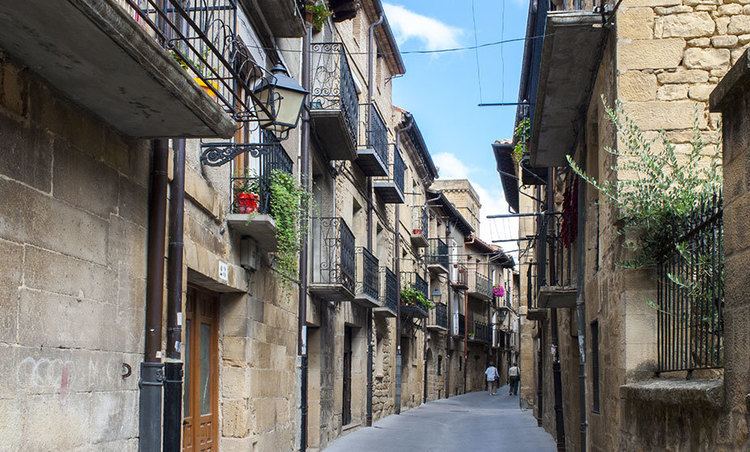Elevation 62 m (203 ft) Area 81.08 km² Population 1,518 (2014) | Autonomous community Basque Country Founded 1164 Time zone CET (UTC+1) Province Álava Local time Saturday 7:20 AM | |
 | ||
Weather 5°C, Wind NW at 2 km/h, 90% Humidity Points of interest Bodegas Ysios, Church of Santa María de l, Villa Lucia, Solar de Samaniego, Primicia - SA - Bodegas | ||
Laguardia (Basque: Guardia) is a town and municipality located in the southern province of Álava, in the north of Spain; it belongs to the region of Rioja Alavesa, in the Basque Autonomous Community. It has a population of 1500; but in the past it had 2500.
Contents
- Map of Laguardia C381lava Spain
- Toponym
- Neighborhoods
- History
- Economy
- Monuments and places worth visiting
- Notable people
- Music
- Sports
- References
Map of Laguardia, %C3%81lava, Spain
The place lies over a hill and it is surrounded by a wall that the King Sancho the Strong ordered to build. There are still preserved five different entries to access the city. Their names are: Mercadal, Butchers, Páganos, San Juan and Santa Engracia. Additionally, the streets and surroundings of Laguardia still keep a medieval atmosphere that give the city an ancient touch.
Regarding the economy, its main strength is the wine industry. Indeed, the wine is elaborated and processed in numerous wineries.
Toponym
During the Middle Ages, it appeared with names such as Leguarda, Giardia, Guard, Guoardia, Lagarde, and Laguoardia until the current name was finally fixed. Indeed, the full and complete name with which the town is known currently is La Guardia de Navarra Sonsierra.
There has been some controversy about the Basque name of the town. In the late nineteenth century, the belief that before granting the "letter of villazgo" in 1164, the population of Laguardia was called Biasteri had spread. Many people saw "Biasteri" as a name of Basque origin and folk etymologies such as "bi haitz herri" became popular. As a consequence, the term Biasteri was used as the Basque name of the town until recently.
Nevertheless, in the late twentieth century, philologists and historians reached the conclusion after some research that Biasteri was the ancient name given to the nearby town of Viñaspre, not of Laguardia. Therefore, the association made until that date was not correct, and the Basque Language Academy, Euskaltzaindia, ruled that the Basque standard name of the town is Guardia.
Neighborhoods
Laguardia has three separate neighborhoods:
History
Laguardia possesses a very rich historical past. At a place called La Hoya, there is an important archaeological site. It is a pre-Roman settlement of Celtiberian of Berona ethnic and it covers an extensive period of more than a thousand years or so since the twelfth century. BC to the second century. BC.
Additionally, the town received certain privileges regarding jurisdiction during the reign of the king of Navarre Sancho VI "El Sabio" in 1164. The initial demarcation covered areas from "Las Conchas de Haro" to "Soto Inigo Galindez", in the current term of Viana. It was the beginning of the community of "Villa y Tierra" . Eventually, new villas were created in the surroundings changing the focus of attention to other territories such as San Vicente, Labraza and Viana. In any case, it was the main square of the Sonsierra of Navarra during most part of the medieval period.
Economy
As mentioned above, the core of the economy in Laguardia focuses on the world of viticulture (grape growing, winemaking and wine industry). Laguardia is the capital of one of the most famous wine regions of Spain, Rioja Alavesa. Additionally, both in Laguardia and its surroundings, a wine known as the Denominación de Origen Calificada Rioja which is useful to distinguish particular vines produces in some specific regions.
Monuments and places worth visiting
Notable people
Music
The town of Laguardia has always been known for having among its inhabitants talented musicians in all its aspects. Thus, several generations of bagpipers have led to the Day of the Piper, one of the most important festivals, held in honor of illustrious pipers of this town and its surroundings. They are also an important part of the musical history of the people and their municipal band, which has been active for 130 years. Also, several rock groups, such as: "Tubo Skape" or "Allá Cuidaos" are part of the musical history town.
Sports
The town has a football team of Regional Division. An earlier formation competed in the Regional League of La Rioja. In 1967, the sixteenth stage of the Cycling Tour of Spain started in Laguardia, a time trial finishing in Vitoria. The winner was the French Raymond Poulidor.
